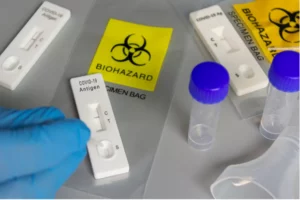Misrepresentations Abound From Members of Congress
July 10, 2024

Early last month the former director of the National Institute of Allergy and Infectious Diseases (NIAID), Dr. Anthony Fauci, testified before a U.S. House of Representatives select committee that is supposedly investigating aspects of the pandemic. The hearing descended into a series of sometimes outlandish allegations that included several misrepresentations of fact by members of the House Committee.
One of them was the assertion that the so-called “six-foot rule” was an arbitrary idea that harmed people and has no basis in science. Another was the allegation that scientists at the National Institutes of Health personally pocketed $710 million in royalties from drug companies during the pandemic. Neither is true.
Six Feet Was a Reasonable Intuition
The six-foot distancing recommendation was intended to limit the spread of the virus that causes Covid-19. In his testimony, Dr. Fauci noted that there have been no definitive studies demonstrating that six feet is exactly the right distance to lower the chances that the virus (SARS-Cov-2) can be passed from one person to another. But that does not mean the recommendation was capricious, as some members of Congress seem to think.
Remember that when the pandemic started, we were faced with a novel virus about which we knew little concerning the dynamics of how it is transmitted. It was at first believed that the Covid-19 virus is transmitted by droplets that quickly drop to the ground after an infected person sneezes or coughs. From what is known about other droplet-borne infections, like the common cold and seasonal influenza viruses, it made sense to recommend that people maintain a safe distance from each other to limit the chance that droplets containing live virus could reach another person. As Tanya Lewis wrote in Scientific American, “…six feet of distancing was widely seen by experts as a reasonable benchmark for avoiding that type of [droplet] exposure—a recommendation that was fairly easy to remember and estimate by eye.” Again, six feet of distance made sense based on what is known about how infected droplets travel.
While it is true that the Covid-19 virus is transmitted via droplets, it later emerged that it is also aerosolized and carried airborne much farther than droplets. Staying away from an infected person is still a reasonable idea to reduce the chances of transmission, but six feet is probably not a sufficient distance to prevent transmission of the very tiny virus particles that are aerosolized and airborne. Gradually, the six feet of social distancing once held as an important component for Covid-19 transmission restriction has faded away as new knowledge about the virus accumulates. But to say that the original six-foot notion was arbitrary is simply incorrect.
When faced with an emergent infectious pathogen and a health emergency like Covid-19, scientists and public health experts must make recommendations based on best scientific intuition. There simply was not enough time to do rigorous clinical trials to figure out whether six feet of social distancing is better than five feet or seven feet. We also have very limited data on whether the six-foot recommendation was indeed effective, although studies have indicated that some social distancing practices did reduce the number of people infected with SARS-CoV-2. In the face of all the other things that have been tried to limit transmission of the Covid-19 virus, some of which are now known to be clearly effective, like wearing face masks and vaccines, it is going to be extremely difficult if not impossible to do retrospective studies on social distancing. Once again, however, it is a total misrepresentation of the facts to assert that the “six-foot rule” was unscientific or arbitrary. It was the best educated guess scientists could make in the absence of definitive evidence.
Individual Scientists Did Not Pocket $710 Million in Royalties
Some members of the Congressional committee also latched onto a rumor that NIH scientists had lined their pockets with drug company money during the pandemic. Once again, this is a blatant bit of misinformation. When NIH scientists make discoveries that are ultimately used by pharmaceutical companies to develop new medications, federal law allows for both the government and its scientists to claim royalties based on the profits made by the companies. Almost all of the $710 million in royalty payments during the pandemic that the members of the Congressional committee became so exercised about, however, were paid to the federal government and not to any individual scientists. Taxpayer money supports an enormous amount of U.S. government-sponsored medical research, and it is important that the public receives some of the financial benefit derived from that government-funded research. People who oppose the Covid-19 vaccines, which are incontrovertibly safe and effective, would like to believe that government scientists became rich colluding with drug companies to foist ineffective and unsafe medications and vaccines on us. That is simply untrue. Instead, some of the profits derived from Covid-19 vaccines and medications were plowed back into the federal government’s coffers to support further research. That, in our view, is an appropriate public benefit.
Dr. Fauci Stood Strong
How did Dr. Fauci weather this storm of inaccurate assertions? By one account “For his part, Fauci—a veteran of numerous appearances before Congress-held his ground, assailing accusations made against him as ‘seriously distorted,’ ‘absolutely false,’ and ‘simply preposterous.’” Indeed, Dr. Fauci seemed unperturbed when one member of the committee, Representative Marjorie Taylor Greene (R-GA), declared: “You should be prosecuted for crimes against humanity. You belong in prison.” Once again, hyperbolic rhetoric seemed to reign supreme during this three and a half hour hearing. The American public should be grateful to Dr. Fauci for bearing the brunt of it and for his outstanding leadership during the pandemic. Far from deserving opprobrium, Dr. Fauci should be lauded not only for his scientific and public health achievements but for his ability to withstand withering criticism based on misinformation and faulty logic.
We were also disturbed by columnist Zeynep Tukefci’s take on the hearing in the New York Times. Tukefci seems to have bought into many of the misrepresentations hurled around during the Congressional hearing and used them to criticize the way federal scientists and public health officials handled the pandemic. “Their delays, falsehoods and misrepresentations had terrible real-time effects on the lives of Americans,” she wrote after the hearing. “Failure to acknowledge the basic facts of Covid transmission led authorities to pointlessly close beaches and parks, leaving city dwellers to huddle in the much more dangerous confines of cramped and poorly ventilated apartments.” She goes on to accuse the government of misleading “people about how Covid is transmitted.” We have trouble understanding the basis for these statements, however. It is not true that closing beaches and parks was “pointless.” Again, the evidence is mixed on whether these measures did in fact reduce the spread of the virus, but there is evidence from observational studies that social distancing measures like public closures were effective. Furthermore, we wonder where the evidence is that public closures increased the risk of getting Covid-19 by forcing people to “huddle” in their apartments. Finally, we don’t see the basis for asserting that anyone “misled” the public about how the virus is transmitted. We simply didn’t have all the facts at first; when the evidence that the virus is aerosolized and airborne emerged that was factored into public health guidelines.
No one disputes that we could have done better handling the pandemic. We have long bemoaned the shortcomings of public health communication practices in the United States, which often fail to deliver clear and accessible messages and to acknowledge areas of uncertainty. There was unfortunate resistance in many circles to efficacious ways to limit the severity of the pandemic, like using face masks and getting vaccinated. And these shortcomings are unfortunately once again appearing as we witness the way the threat of the H5N1avian bird flu is being handled.
But hurling unfounded accusations at a dedicated public scientist, like Dr. Anthony Fauci, is simply unacceptable. We need to condemn the practice of fabrication and misdirection that characterizes too much of the dialogue about Covid-19 coming from some circles in Congress. Any investigation into how we are handling the pandemic must stick to the facts and keep an eye on how we can do better in the future. That is something we must do, and we hope all members of Congress come around to adopting that premise.
Related Posts

The Lab Leak Hypothesis for the Origin of the COVID-19 Virus is Dangerous
Posted in COVID
The lab leak theory is most likely wrong and engenders mistrust.

As the Data Roll In, We Get a Better Sense of What Worked During the Pandemic
Posted in COVID
While there are some things about COVID and the pandemic that are still unclear, there are many things we can be sure about, including the fact that masks work.

Political Partisanship Can Be Deadly
Posted in COVID
The authors of a new study find that political polarization was often the key factor in people's decisions about whether to mask up, socially distance, and/or get vaccinated.